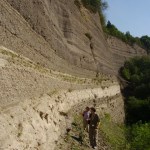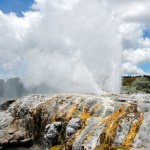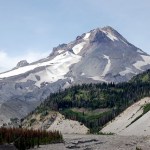cascades
Mt. Hood seen from Portland, Oregon. Image courtesy of the USGS/CVO.
I will be returning to my old haunts in Oregon (got my Ph.D. from Oregon State University - and yes, that is me in the upper left hand corner) for the next 6 days for the the Cascades, CVO and the multitude of igneous-rock-studying folks at Oregon State, Portland State, Univ. of Oregon, Univ. of Washington and so on, there is an awful lot to see. Two sessions I'm especially excited about are on supervolcanic/ignimbrite flareups and the Cascades volcanism and tectonics. A couple of these talks/posters I had some hand in, so…
Happy Earth Science Week!
Mt. Baker in Washington, USA.
The Mount Baker Volcano Research Center (MBVCC) run out of Western Washington University has posted a series of new pictures and movies of the summit region of Mt. Baker (taken from 2006 to 2009). They also sent out links to some great images of the recently-exposed edge of the old crater rim on Mt. Baker. The crater had been buried by the ice/snow cap on the volcano until this year, but John Scurlock was able to capture a photo of the rim of the crater from an airplane this summer. The grey layer is ash/tephra likely from activity at…
A bit of news for your last Monday in September:
Pumice deposits from the ~13,000 year old Laacher See eruption. Image by Erik Klemetti, taken in August 2007.
More press for Dr. Joyce and his campaign to make the people of Australia terrified that volcanoes will destroy them. He warns of "new volcanoes" springing up in the Ballarat region to the northwest of Melbourne (which, incidentally, is where I pointed out might be the most likely place for future volcanism). Yes, sure, we should expect that a new, unknown scoria cone may form in the Newer Volcanic Province - I mean, that is what…
Some brief tidbits for your Wednesday:
The view of Mt. Saint Helens from the Johnston Ridge Observatory.
There is a decent article about research being done at a dissected caldera system in the Italian Alps' Sesia Valley. The caldera in question is the Permian in age (248-298 million years old) so don't expect to find it in the GVP database, but the outcrops of this ancient caldera are especially well exposed, allowing for a cross section of volcano and plutonic rocks across 25 km of crustal depth (all of which is now at the surface thanks to hundreds of millions years of tectonics). It…
Eruptions reader Doug pointed out in a recent comment that the seismicity at Mt. Rainier in Washington has increased over the last month or so. Take a look for yourself:
Mt. Rainier seismicity over the last year (8/2008 to 9/2009). Image courtesy of PNSN
Taking a closer look, over the last week there has been 7 earthquakes over the last 5 days - all between M1-3 - near Rainier, most calculated to be between 1.5 to 5.8 km depth.
Any thoughts? I see a lot more noise (earthquakes) between 3-6 km depth. It could as benign as seismicity due to fluid in the extensive hydrothermal system at Rainier…
Again, sorry about the paucity of posts. Getting prepared to move 3/4 of the way across a continent will do that. Look for the next Volcano Profile, this time for Erebus in Antarctica, to be posted sometime in the next week or so.
We did get some news over the weekend of a large eruption at Shiveluch. The volcano in Kamchatka has been active all summer, but on Saturday it produced a 5,000 meter / ~23,000 foot ash plume. This was accompanied by 170 earthquakes and multiple avalanches, likely produced by the collapsing dome on the summit of the volcano. There is a little more information about…
Chaiten in Chile erupting in January 2009. Even after over a year of activity, Eruptions readers are still captivated by the volcano.
Thanks for sending me your questions about volcanoes and volcanism. I'll try to tackle some hear - but as always, keep the questions coming! Send them to
For those of you who have submitted a question but don't see the answer here, do not fret. Likely it just means that I needed to do a little more research into the question and will get to it in a later mailbag!
So, without further ado ...
Mark M.: Here in the Appalachians we have very dense crystalline rock…
I won't try to recap all the news from last week, but I did notice a few articles from this weekend worth noting:
The Big Obsidian Flow at Newberry Volcano. This rhyolite lava flow erupted at ~1,300 years ago.
Geologists in Greece are keeping an eye on a submarine volcano called Columbus. Apparently a number of M4+ earthquakes have been reported, the sea floor has deformed and there have been "hot air eruption" (? ... I am a little skeptical of the last one without more details). The article is a little fuzzy on the details: the volcano is 6.5 meters southeast of Santorini and the Santorini…
Mt. Saint Helens in Washington state, USA
I'm back from my sojourn to New England and its time to play catch up. First things first!
There has been a lot of chatter in my inbox and on the comments here at Eruptions about the study/press release from Graham Hill's research group talking about the potential for a supervolcano forming at Mt. Saint Helens. This study (presented at the AGU Spring Meeting) was based on a magnetotelluric study of the area around (and below) Saint Helens. For those of you unfamiliar with magnetotellurics, it uses instruments that measure the magnetism and electrical…
Pohutu Geyser in Rotorua, New Zealand. Image taken by Erik Klemetti in January 2009.
It has been busy busy week for me, capped off today with a talk about my field work in New Zealand (see above), so I don't have much to say. Not much new news today about the Saudi Arabian earthquake swarms, but again, I'll keep my eyes pealed (incidentally, I still haven't been able to figure out why no western news sources have even mentioned the swarm).
Anyway, here's are some volcanic tidbits to enjoy over the long weekend:
Vog, as seen from space. Volcanic fog, fashionably shortened to "vog" is a real…
Mount Saint Helens less than 30 seconds after a sector collapse that triggered one of the largest eruptions in the Cascades in the last 500 years.
Today is the 29th anniversary of the dramatic eruption of Mount Saint Helens in Washington state. The eruption dramatically changed the landscape around the volcano along with greatly increasing our understanding of volcanic sector collapses and explosive eruptions. I was going to write a larger entry on the event, but alas, I will instead be lecturing to 100 UC Davis students about the event today instead (sorry folks!)
Instead, if you want to…
Back in the days when Eruptions was on Wordpress, I held a vote about what volcano should be the next to be profiled on this blog. The winner was Mt. Hood in Oregon, and after much waiting, the profile is here. I will actually be out of town until Monday doing some house shopping in this little town. Enjoy this look at one of the most picturesque (and hazardous - #4 in fact) volcanoes in the lower 48 states.
VOLCANO PROFILE: MT. HOOD
Mt. Hood, Oregon in August 2008 taken by Erik Klemetti.
Location: Oregon, U.S.A.
Height: 3,426 m / 11,240 ft
Geophysical location: Along the Cascade arc where…
Mt. Baker in Washington. Image taken by John Scurlock.
Eruptions reader Robert Somerville brought to my attention the Mount Baker Volcano Research Center, a "clearinghouse for research on Mt. Baker" in Washington state. The center is a non-profit organization that is affiliated with the Geology Department at Western Washington University - and from the looks of the website, they've already done a great job in compiling a lot of information about Mt. Baker, including an excellent eruptive history of the volcano. Mt. Baker is one of the most active Cascade volcanoes, with active fumarolic…
Image courtesy of USGS/CVO, taken March 8, 2005 from the Cascades Volcano Observatory, Vancouver, WA
For those of you looking for something to relax with and read this weekend, you could wander over to the USGS website and download yourself a copy (for free and legally) of "A Volcano Rekindled: the Renewed Eruption of Mount St. Helens, 2004-2006" (USGS Professional Paper 1750). The report comes in at a mere 872 pages (that's 697 MB download for the whole report), but you can download the pieces that interest you most as well instead of the whole shebang.
Now, I haven't read the whole thing,…
So, there has been a lot of talk about "volcano monitoring" over the last 24 hours, now hasn't there?
Now, I'm not going to revisit this discussion, but as an example of why it might be important, there is an article today about the location of the Bataan Nuclear Power Plant in the Philippines (near the potentially active caldera Natib). These are the sorts of issues that need to be dealt with in regards to volcano monitoring - the cascading effect of an eruption. During the 1980 eruption of Mt. Saint Helens, there was a chance that volcaniclastic sediment from the eruption could have dammed…
This is the second of eight posts on evolutionary research to celebrate Darwin's bicentennial.
What do you get when one species splits into separate lineages? Two species? Think bigger...
When new species arise, they can set off evolutionary chain reactions that cause even more new species to spring forth - fresh buds on the tree of life create conditions that encourage more budding on different branches.
Biologists have long suspected that these "cascades of speciation" exist but have struggled to test them. Enter Andrew Forbes from the University of Notre Dame - his team of has…
The "eruption watch" continues at Redoubt ... Saturday revealed that things are getting hotter at the summit near the 1989/1990 dome (see picture above that made Redoubt famous in 1989). The overflight of the volcano revealed new holes in the summit glacial and a multitude of muddy streams formed from the meltwater. This area of very intense fumarolic activity is just below the 1989/1990 dome (~7,100 feet) and has been growing over the past few days. They also report an area at ~9,000 feet on the volcano that shows signs of ice collapse, indicating heat from underneath the snow and ice (…
The BBC is reporting today on a study published in Earth and Planetary Science Letters that attempts to establish a connection between large earthquakes and subsequent volcanic eruptions. The study is focussed on large Chilean earthquakes over the last 200 years (Chile has had some of the biggest, hitting M9 on the Richter Scale) and then examining the number of volcanic eruptions that followed. They find that activity increased in the year after the earthquakes. This suggests that many volcanoes might be "primed" to erupt and just need a catalyst like a large seismic event to promote…
The only volcanic arc in the lower 48 states continues to be pretty darn quiet according to the USGS. The Cascade range that spans from Lassen Peak in the south to Mt. Baker in the north (and maybe Mt. Garibaldi in Canada) has been remarkably quiet in terms of eruptions for the last century. In fact, only Mt. Saint Helens and Lassen Peak have erupted since 1900 - and most of the volcano have shown very few signs of even coming close to eruption beyond minor seismic swarms, steaming or land deformation. This is in contrast to the reports from the 1800s that suggest that Hood, Shasta, St…
I am back from my trek through the Oregon and California Cascades - including stops at Lassen Peak/Chaos Crags, Hood, Three Sisters and Crater Lake (an added bonus). I'll try to catch up on the volcano news I've missed and post on anything exciting that happened soon, but otherwise I'll be posting new news as it occurs.
In the meantime, here's a picture I took of Rock Mesa (foreground) and South Sister (background) taken from the Pacific Crest Trail. Rock Mesa is a ~2,700 year old rhyolite flow that appears to have erupted multiple pumices and has some impressive flow banding of the rhyolite…



